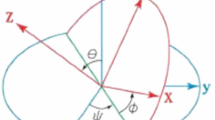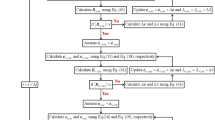Abstract
The analysis of the paper “New exact solution of Euler’s equations (rigid body dynamics) in the case of rotation over the fixed point” is made. It is shown that the solution is reduced to a well-known subcase of the Euler’s case: steady rotation.
Similar content being viewed by others
Avoid common mistakes on your manuscript.
1 The consideration of the problem in the absolute system of coordinates
In a recent article [1] Ershkov reported a new exact solution of Euler’s equation. Thorough analysis of this work showed that the proposed “generalization” of the Euler’s case is just a special case of the Euler’s case. To verify this, let us consider the problem in the absolute system of coordinates \({ OXYZ}\). Denote by \(\mathbf{K}_{{ OXYZ}} \) the components of the angular momentum vector with respect to the fixed point of the rigid body O, the gravity force by \(\mathbf{P}_{{ OXYZ}} \), \({{\varvec{\upgamma }}}_{{ OXYZ}} =-\mathbf{P}_{{ OXYZ}} /\left| {\mathbf{P}_{{ OXYZ}} } \right| =-\mathbf{P}_{{ OXYZ}} /P\), the point of gravity force application \(\mathbf{r}_{{ OXYZ}} \).
The main assumption of the article [1] is the integral of motion (2.1) \(\left( {\mathbf{K}_{{ OXYZ}} } \right) ^{2}=C_0^2 \). The equality (2.1), the first equation in (1.3) \(\left( {{{\varvec{\upgamma }}}_{{ OXYZ}} } \right) ^{2}=1\) and the second equation in (1.3) \(\mathbf{K}_{{ OXYZ}} \cdot {{\varvec{\upgamma }}}_{{ OXYZ}} =C_0 =\hbox {const}\) imply the colinearity of the vectors \(\mathbf{K}_{OXYZ} \left\| {\varvec{\upgamma }}_{{ OXYZ}}\right. \) (this holds in any axes set, in particular, in the frame of reference fixed in the rotating body (2.2)). This fact follows from:
So we obtain that
By the angular momentum theorem [2], we have that
and, therefore,
i.e. the momentum of external forces is identically zero. Therefore, the cases considered in the paper (paragraphs 3 and 4) cannot be beyond the classical Euler’s case. Let us show that these cases are just subcases of the Euler’s case.
As we consider a rigid body \(|\mathbf{r}_{{ OXYZ}} |=\hbox {const}\) and taking into account (4), we obtain that
which may only hold in the following two cases
-
1.
\(\mathbf{r}_{{ OXYZ}} =0\)—this is a trivial case,
-
2.
\(\mathbf{r}_{{ OXYZ}} \ne 0\), but the motion is steady rotation about one of the principle axes, and the gravity center lies on this axis and the gravity force vector is parallel to this axis. This case is easily understood using the Poinsot geometrical interpretation [2, 3].
2 The consideration of the problem in a frame of reference fixed in the rotating body
Now, following the author’s paper, we deduce equation (4) in the frame of reference fixed in the rotating body \({ Oxyz}\), preserving the notations of the variables. (2.2) implies that \(\mathbf{K}_{{ Oxyz}} \left\| {{\varvec{\upgamma }}}_{{ Oxyz}} \right\| \mathbf{P}_{{ Oxyz}} \). Substituting (2.2) in (1.1) and considering (1.2) ((1.1) and (1.2) are the same and agree with corresponding equations in [3]), we get that
that is \(\mathbf{r}_{{ Oxyz}} \times \mathbf{P}_{{ Oxyz}} =0\), which implies (4) in a moving set of axes
which we needed to deduce.
3 The hidden triviality of paragraph 3 in paper [1]
Let us show that proposition (3.1) in the case \(a=0\) in paragraph 3 implies that the rigid body is at rest.
Indeed, in the case \(a=0\) statement (7) corresponds to: firstly,
and, secondly,
Substituting (8) in the first equation (1.1) and considering the first equation in (6), we obtain that
Considering the author’s inequalities \(I_2>I_1 >I_3 \), \(c\ne 0\) and (3.1), from (9) we obtain that \(\Omega _2 =\Omega _3 =0\), thus completing our proof.
4 The stationary rotation in paragraph 4 in paper [1]
Let us show that the case \(a=c=0\) of paragraph 4 implies that \(\Omega _1 =\Omega _3 =0,\quad \Omega _2 ={ const}\).
Indeed, the equalities \(a=c=0\) and (7) imply that \(\Omega _1 =\Omega _3 =0\). Considering also (2.1) we obtain that \(\Omega _2 =\hbox {const}\), thus completing the proof.
Thus, in this case, the body is rotating about the principle axis with constant angular speed \(\Omega _2 =\hbox {const}\) (steady rotation). In equation (4.3), \(f_1 =f_2 =0\), and thus in this equation, we have zero divided by zero.
References
Ershkov, S.: New exact solution of Euler’s equations (rigid body dynamics) in the case of rotation over the fixed point. Arch. Appl. Mech. Springer, Berlin Heidelberg 84, 385–389 (2014). doi:10.1007/s00419-013-0806-x
Goldstein, H.: Classical mechanics, 2nd edn. Addison-Wesley, Boston (1980). ISBN 0-201-02918-9
Magnus, K.: Kreisel—Theorie und Anwendungen. Springer, New York (1971)
Acknowledgments
The work was supported by the Russian Science Foundation, project No 14-19-01633.
Author information
Authors and Affiliations
Corresponding author
Rights and permissions
About this article
Cite this article
Sanduleanu, S.V., Petrov, A.G. Comment on “New exact solution of Euler’s equations (rigid body dynamics) in the case of rotation over the fixed point”. Arch Appl Mech 87, 41–43 (2017). https://doi.org/10.1007/s00419-016-1173-1
Received:
Accepted:
Published:
Issue Date:
DOI: https://doi.org/10.1007/s00419-016-1173-1




